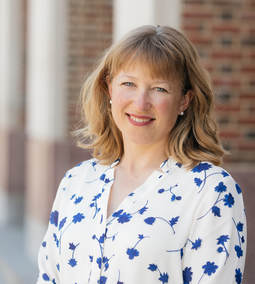
Bess Koffman
Assistant Professor of Geology
Colby College
Waterville, ME
E-mail: bess.koffman[AT]colby[DOT]edu
Curriculum Vitae
Google Scholar page
OrcID
Assistant Professor of Geology
Colby College
Waterville, ME
E-mail: bess.koffman[AT]colby[DOT]edu
Curriculum Vitae
Google Scholar page
OrcID
News and Updates
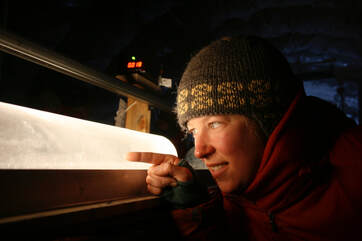
November 2021
Ever wondered how to figure out where dust comes from? Our new study published in Quaternary Science Reviews uses strontium and neodymium isotopic ratios and rare earth elements to identify the likely sources of dust supplying Siple Dome, Antarctica. We find unusual isotopic ratios that point to specific regions of East Antarctica as likely sources of dust. (Photo is actually of me beside a section of the WAIS Divide ice core. Photo credit: Thomas Bauska)
Ever wondered how to figure out where dust comes from? Our new study published in Quaternary Science Reviews uses strontium and neodymium isotopic ratios and rare earth elements to identify the likely sources of dust supplying Siple Dome, Antarctica. We find unusual isotopic ratios that point to specific regions of East Antarctica as likely sources of dust. (Photo is actually of me beside a section of the WAIS Divide ice core. Photo credit: Thomas Bauska)
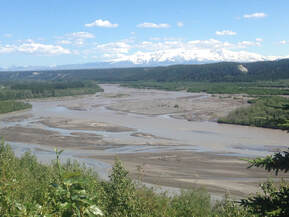
March 2021
Excited to share our new paper published in Global Biogeochemical Cycles, which evaluates different dust and volcanic ash sources as suppliers of iron and other trace metals to the northeast Pacific. We found that glacier-derived dust has significantly more iron that is likely to be bioavailable than either desert dust or volcanic ash. This paper was the result of a lot of work by Colby undergraduates, including Meg Yoder, whose thesis project generated the initial data for the paper! Photo shows the sediment-laden Copper River of Alaska, with the Wrangell Mountains in the background.
Excited to share our new paper published in Global Biogeochemical Cycles, which evaluates different dust and volcanic ash sources as suppliers of iron and other trace metals to the northeast Pacific. We found that glacier-derived dust has significantly more iron that is likely to be bioavailable than either desert dust or volcanic ash. This paper was the result of a lot of work by Colby undergraduates, including Meg Yoder, whose thesis project generated the initial data for the paper! Photo shows the sediment-laden Copper River of Alaska, with the Wrangell Mountains in the background.
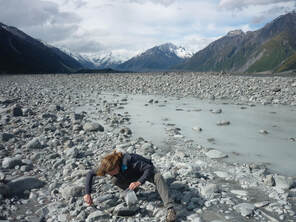
January 2021
Our new paper on New Zealand as a source of dust to the Southern Hemisphere is published in Quaternary Science Reviews! We developed a suite of new Sr-Nd-Pb isotope and major/trace element data to characterize the NZ South Island as a dust source. We also provide new data from several important dust source regions of Australia. Check out the video on the "Multimedia" page to learn more.
Our new paper on New Zealand as a source of dust to the Southern Hemisphere is published in Quaternary Science Reviews! We developed a suite of new Sr-Nd-Pb isotope and major/trace element data to characterize the NZ South Island as a dust source. We also provide new data from several important dust source regions of Australia. Check out the video on the "Multimedia" page to learn more.
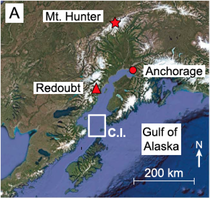
May 2018
Congratulations to David Polashenski and co-authors on the recent paper in Journal of Geophysical Research - Atmospheres! The paper, "Denali ice core methanesulfonic acid records North Pacific marine primary production," describes recent work to validate a proxy for phytoplankton growth in the North Pacific. Using the 1200-year ice core MSA record, we hope to provide long-term context for modern observations of declines in primary production.
Congratulations to David Polashenski and co-authors on the recent paper in Journal of Geophysical Research - Atmospheres! The paper, "Denali ice core methanesulfonic acid records North Pacific marine primary production," describes recent work to validate a proxy for phytoplankton growth in the North Pacific. Using the 1200-year ice core MSA record, we hope to provide long-term context for modern observations of declines in primary production.
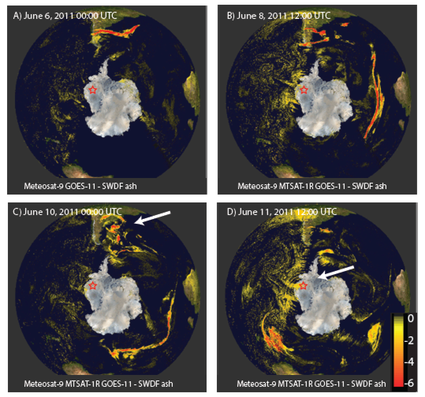
August 2017
My colleagues and I have two new papers out this month. The first, published in Journal of Geoscience Education, describes our approach for incorporating scientific argumentation into a global change course to improve student writing and learning. The second, in Journal of Geophysical Research - Atmospheres, provides evidence of rapid transport of ash and sulfate from the June 2011 eruption of Puyehue-Cordón Caulle (Chile) to West Antarctica. This latter paper developed from Eleanor Dowd's First-Year Women in Science project at Dartmouth. Congratulations on your first paper, Eleanor!
Composite satellite imagery showing ash produced by the Puyehue-Cordón Caulle eruption, which began 4 June 2011. From Koffman et al., 2017, Journal of Geophysical Research - Atmospheres, doi: 10.1002/2017/JD026893.
My colleagues and I have two new papers out this month. The first, published in Journal of Geoscience Education, describes our approach for incorporating scientific argumentation into a global change course to improve student writing and learning. The second, in Journal of Geophysical Research - Atmospheres, provides evidence of rapid transport of ash and sulfate from the June 2011 eruption of Puyehue-Cordón Caulle (Chile) to West Antarctica. This latter paper developed from Eleanor Dowd's First-Year Women in Science project at Dartmouth. Congratulations on your first paper, Eleanor!
Composite satellite imagery showing ash produced by the Puyehue-Cordón Caulle eruption, which began 4 June 2011. From Koffman et al., 2017, Journal of Geophysical Research - Atmospheres, doi: 10.1002/2017/JD026893.
